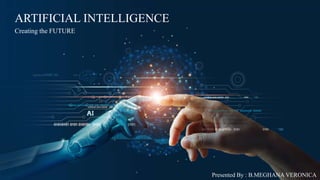
Artificial Intelligence
- 1. ARTIFICIAL INTELLIGENCE Creating the FUTURE Presented By : B.MEGHANA VERONICA
- 2. OBJECTIVE I N T R O D U C T I O N E A R LY H I S T O RY C U R R E N T S TAT U S F U T U R E O F A I L I M I TAT I O N S O F H U M A N M I N D A D VA N TA G E S & D I S A D VA N TA G E S C O N C L U S I O N 2
- 3. 3 INTRODUCTION W H AT I S A I ? Artificial Intelligence refers to the simulation of human intelligence in the machines that are programmed to think like humans and mimic their actions. AI is based on the principle that human intelligence can be defined in a way that a machine can easily mimic it and execute tasks from the most simple to those that are even more complex. 3
- 4. EARLY HISTORY L E T ’ S D I V E I N 4
- 5. 5 The term AI was invented in 1950’s , but AI become more popular today , thanks to increased data volumes, advanced algorithms, and improvements in computing power and storage. Early AI research in the 1950’s explored topics like problem solving and symbolic methods. In the 1960’s , the US Department of Defense took interest in this type of work and began training computers to mimic basic human reasoning. This early work paved the way for the automation and formal reasoning that we see in computers today , including decision support systems and smart search systems that can be designed to complement and augment human abilities.
- 6. AI was invented several years ago. In the past , many people associated AI with robots. But it plays a crucial role in our lives now. Personal gadgets media streaming gadgets, smart cars, and home appliances use artificial intelligence. AI have taken many shapes and forms over recent years i. Mobile Phones (Siri/ Cortana) ii. Video Games Characters iii. GPS/ Voice Recognition iv. Robotics Google has been a major play on AI transcendence and Deep Learning. There are so many ways AI are used behind the scenes to impact our everyday lives. There are some more examples that shows how artificial intelligence is used in day-to-day activities such as : i. Social media ii. Digital Assistants iii. Self-Driving and Parking Vehicles iv. Email communications v. Web searching vi. Education vii. Heavy Industry etc. CURRENT STATUS 6
- 7. T H E F U T U R E O F A R T I F I C I A L I N T E L L I G E N C E Artificial Intelligence is impacting the future of virtually every industry and every human being AI has acted as the main driver of emerging technologies like big data, robotics and IoT and it will act as a technological innovator for the foreseeable future. AI is going to permeate every job sector in the future. It can create new career paths in the field of Machine Learning , Data Mining , and analysis, AI Software development, program management and testing. AI is the latest buzzword in Tech. All the major enterprises will make use of AI in the future to improve their productivity. Tech giants like Apple , Google and Facebook have already climbed on the bandwagon of AI.
- 8. LIMITATIONS OF HUMAN MIND 8 Object recognition. People cannot properly explain how they recognize objects. Face recognition. Cannot be passed on to another person by explanation. Naming of colors. Based on learning, not on absolute standards.
- 9. Advantages & Disadvantages of Artificial Intelligence 9 ADVANTAGES : Reduction of human error. Takes risks instead of Humans. Available 24*7. Helping in Repetitive jobs. Digital Assistance. Faster Decisions. Daily Applications. New Inventions. DISADVANTAGES: High Costs of Creation Making Humans Lazy Unemployment No Emotions Lacking out of Box Thinking
- 10. 10 CONCLUSION Artificial Intelligence and the technology are one side of the life that always interest and surprise us with the new ideas, topics , innovations, products … etc. AI has slowly but surely entered every area of our lives , from online shopping to tv viewing to everything. AI in other words, is the study of man-made computational devices and systems. “AI IS GOING TO CHANGE THE WORLD MORE THAN ANYTHING IN THE HISTORY OF MANKIND.” 10
- 11. THANK YOU :) “Artificial Intelligence is a tool , not a threat.”